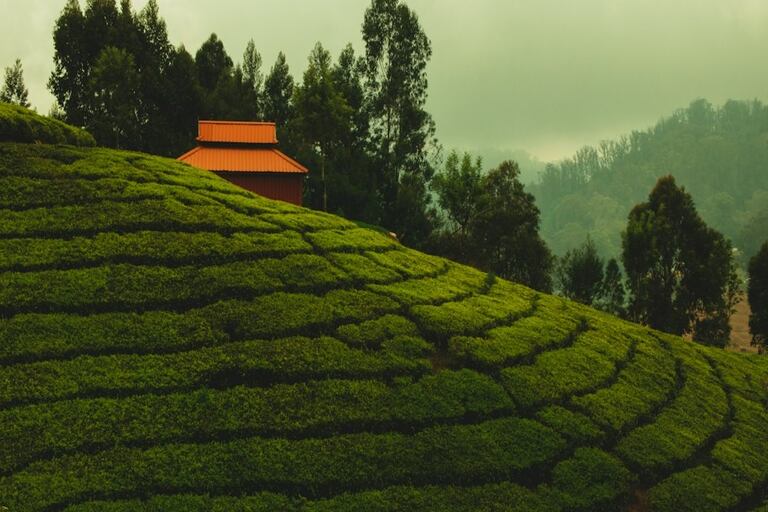
Soulful Serenity in Bodh Gaya: The Place of Enlightenment & Buddhist Pilgrimage
Table of contents
Millions revere Bodh Gaya as the sacred site where Prince Siddhartha attained enlightenment over 2,500 years ago, becoming the Buddha. Nestled in the serene state of Bihar, India, Bodh Gaya is a popular destination of spiritual enlightenment, drawing pilgrims from all corners of the globe. The history of Bodh Gaya is deeply intertwined with the life of Buddha and the development of Buddhism.
This article explores Bodh Gaya, revealing its rich history, tranquil environment, and profound significance as a Buddhist pilgrimage destination.
Why Visit Bodh Gaya In India
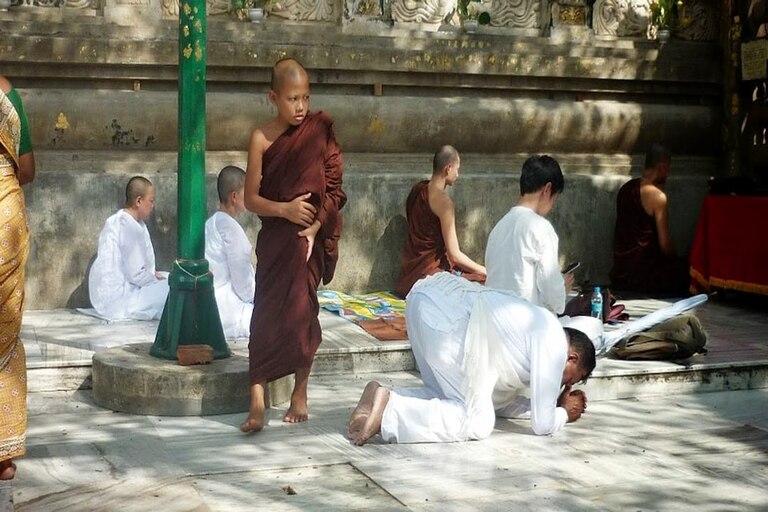
Bodh Gaya
Visiting Bodh Gaya is a must for anyone interested in spirituality and culture. This is the place where Buddha attained enlightenment, making it one of the most renowned pilgrimage sites in the country. The tranquil surroundings, highlighted by the famous temple and sacred tree, provide an ideal space for deep reflection and meditation.
You will also have the opportunity to explore Buddhist teachings and traditions, enhancing your understanding of this ancient faith. So, whether you are on a spiritual quest or simply seeking serenity, Bodh Gaya promises a meaningful and enlightening experience.
Best Time to Visit Bodh Gaya in India
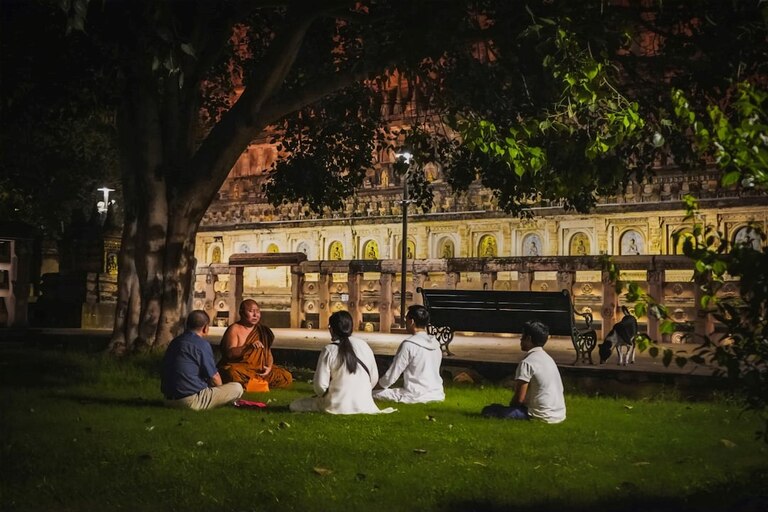
Best Time to Visit Bodh Gaya in India
Bodh Gaya welcomes visitors throughout the year, each season offering its own unique charm. The months of October to March mark the peak tourist season, characterized by pleasant weather and comfortable temperatures. These months are ideal for exploring the region’s outdoor attractions.
During this time, you can witness vibrant festivals such as Buddha Purnima and the Kalachakra Puja, which draw devotees and travellers alike. Alternatively, the monsoon season from June to September brings refreshing showers, rejuvenating the lush green landscape of Bodh Gaya.
How to Reach Bodh Gaya
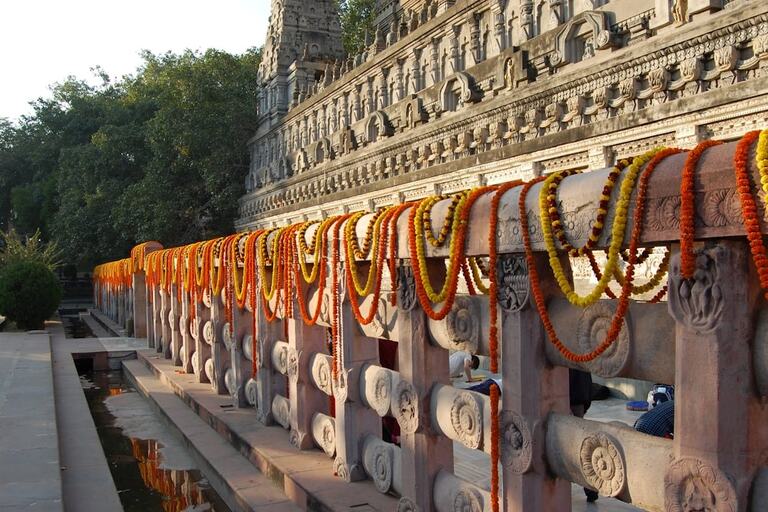
Visiting Bodh Gaya
Bodh Gaya, a destination of pilgrimage for Buddhism in Bihar, India, can be reached easily through various modes of transportation.
- By Air
The nearest airport to Bodh Gaya is the Gaya Airport, situated approximately 12 kilometres away from the town centre. It operates domestic flights from major Indian cities such as Delhi, Kolkata, and Varanasi. From the airport, travellers can hire taxis or use pre-paid taxi services to reach Bodh Gaya.
- By Train
Gaya Junction is the nearest major railway station, around 16 kilometres from Bodh Gaya. It is well-connected to various cities across India, including Delhi, Kolkata, Mumbai, and Chennai, via regular train services. From Gaya Junction, travellers can take taxis, auto-rickshaws, or buses to reach Bodh Gaya.
- By Road
Bodh Gaya is accessible by road via well-maintained national and state highways. It is approximately 110 kilometres from the city of Patna, which is connected to major cities across India by road. Several state-run and private buses operate between Patna and Bodh Gaya, offering a convenient option for travellers.
Reaching Bodh Gaya is relatively convenient, regardless of the mode of transportation you choose. This allows pilgrims and travellers to experience the beauty of this historic Buddhist site with ease.
Buddhist Pilgrimage Places to Visit
If you want to set out on a Bodh Gaya pilgrimage, here is a list of the top Buddhist pilgrimage places to visit.
1. Mahabodhi Temple
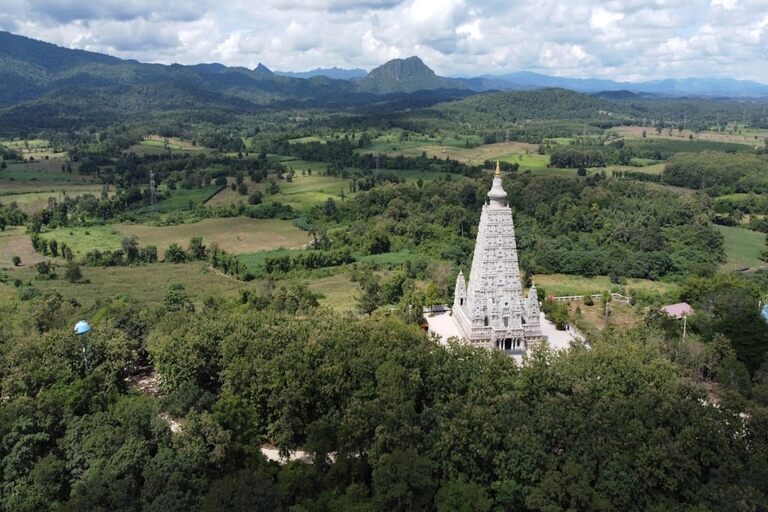
Mahabodhi Temple
At the heart of Bodh Gaya lies the magnificent Mahabodhi Temple, a UNESCO World Heritage Site and the holiest shrine for Buddhists worldwide. This ancient temple, whose complex was built in the 3rd century BCE, marks the spot where the Buddha attained enlightenment under the Bodhi Tree. As you enter the temple complex, you’ll be struck by its towering spire and intricate carvings depicting scenes from the life of the Buddha. The serene ambience of the Mahabodhi Temple creates an atmosphere of profound peace and spiritual resonance. It’s a must-visit destination when visiting Bodh Gaya in India.
2. Bodhi Tree
Adjacent to the Mahabodhi Temple stands the sacred Bodhi Tree. It is under this tree that Siddhartha Gautama attained enlightenment. Believed to be over 2,500 years old, this revered tree serves as a symbol of spiritual awakening. Pilgrims from around the world gather beneath the tree to offer prayers and meditate. The Bodhi tree is among the top Buddhist pilgrimage places to visit, so make sure to add it to your list.
3. Great Buddha Statue
Another popular attraction dominating the landscape of Bodh Gaya is the towering Great Buddha Statue. This is a magnificent monument depicting the seated Buddha in a meditation posture. Standing at an impressive height of 80 feet, this iconic statue represents the Buddha’s timeless teachings of peace, compassion, and wisdom. On your Bodh Gaya pilgrimage trip, you can climb the steps to the statue’s base to offer respect.
4. Dungeshwari Cave Temples
A short distance from Bodh Gaya lies the Dungeshwari Cave Temples, also known as the Mahakala Caves. It is believed that Buddha undertook six years of intense ascetic practices before attaining enlightenment. These ancient caves, nestled amidst rocky hills and dense vegetation, provide a serene setting for meditation and reflection.
Here, you can explore the dimly lit chambers and narrow passages of the caves for a spiritual and immersive experience. Dungeshwari Hills is also a popular trekking destination attracting huge crowds seeking thrilling activities and adventures.
5. Thai Monastery
The Thai Monastery, nestled amidst the serene landscape of Bodh Gaya in India, is a beautiful sanctuary for spiritual seekers and tourists alike. With its distinctive Thai architecture, the monastery is adorned with intricate carvings and vibrant colours. The monastery is surrounded by lush gardens and exudes a serene and calm atmosphere. Inside, visitors are greeted by the majestic statue of Lord Buddha.
The monastery also serves as a centre for meditation and Buddhist teachings, attracting pilgrims worldwide. So, whether you’re drawn to its religious significance or simply seeking a moment of respite, the Thai Monastery offers you the perfect oasis where the mind can find peace and the soul can find solace.
6. Royal Bhutan Monastery
The Royal Bhutan Monastery is a captivating testament to Bhutanese culture and spirituality. Built by the king of Bhutan, this monastery is one of the most popular monasteries in Bodh Gaya that attracts huge crowds. Surrounded by lush greenery and serene landscapes, the monastery stands as a symbol of Bhutan’s rich heritage and deep-rooted Buddhist traditions.
Its intricate Bhutanese-style architecture and elaborate designs reflect the country’s devotion to Buddhist principles. The monastery houses a temple that boasts a 7-foot-high image of Lord Buddha that’s sculpted with Buddhist scriptures and symbols. It also provides lodging facilities for the Buddhist monks. The monastery serves as a sanctuary for Bhutanese pilgrims and international travellers, offering a peaceful retreat where one can immerse oneself in meditation and prayer.
7. Cankamana
Cankamana, also known as the “Cloister Walk,” is a significant site within the Mahabodhi Temple complex in Bodh Gaya. It is a raised platform made of stone slabs, believed to be the path where Lord Buddha walked during his meditation. According to Buddhist tradition, Buddha spent seven days walking back and forth along the Cankamana in deep contemplation after attaining enlightenment under the Bodhi Tree.
Pilgrims visiting the Mahabodhi Temple often engage in the ritual of walking along the Cankamana, symbolising a spiritual journey towards enlightenment. Surrounding the Cankamana are inscriptions and symbols, adding to its historical and spiritual significance. It remains a revered spot for Buddhist devotees seeking inspiration and introspection amidst the sacred grounds of Bodh Gaya.
Activities To Do In Bodh Gaya in India
There are plenty of different activities that you can indulge in on your trip to Bodh Gaya. Here is a list of some activities:
- Meditation and Mindfulness Retreats: Bodh Gaya offers numerous opportunities for meditation and mindfulness practices, with numerous centres and retreats catering to practitioners of all levels. Whether you’re a seasoned meditator or a beginner seeking guidance, you’ll find a supportive community and conducive environment for deepening your practice and cultivating inner peace.
- Puja and Offerings: Participating in traditional Buddhist rituals such as puja (worship) and offerings is a profound way to connect with the spiritual essence of Bodh Gaya. You can join in daily rituals, offering flowers, incense, and prayers as expressions of devotion and gratitude to the Buddha and his teachings.
- Cultural Immersion: Immerse yourself in the vibrant culture and traditions of Bodh Gaya by attending cultural events, teachings, and workshops conducted by esteemed Buddhist teachers and scholars. From traditional music and dance performances to insightful lectures on Buddhist philosophy, these cultural activities offer a deeper understanding of the region’s rich heritage.
- Shopping and Souvenirs: Shop for souvenirs and handicrafts at local markets, where you can find items such as Tibetan prayer flags, statues, incense, and traditional clothing.
- Explore Surrounding Villages: Take a day trip to nearby villages and countryside to experience rural life in Bihar and interact with local communities.
Accommodation and Dining
In Bodh Gaya, you’ll find various accommodation options to suit every budget and preference. You can pick from a wide selection of options online from cosy guesthouses and boutique hotels to luxurious resorts and monastic stays. Many of these establishments offer serene surroundings, comfortable amenities, and warm hospitality, ensuring a restful and rejuvenating stay during your pilgrimage.
When it comes to dining, Bodh Gaya offers a diverse culinary landscape, with restaurants and eateries serving a variety of cuisines ranging from traditional Indian and Tibetan dishes to international fare. Whether you’re craving hearty vegetarian meals, aromatic chai tea, or delectable sweets, you’ll find plenty of options to satisfy your palate and nourish your body.
Things To Keep In Mind When Planning A Trip To Bodh Gaya
- Weather and Climate: Be aware of the weather conditions in Bodh Gaya during your planned travel dates and pack accordingly. The region experiences hot summers and mild winters, so plan your clothing accordingly.
- Accommodation: Book your accommodation in advance, especially during peak tourist seasons.
- Health and Safety: Take necessary health precautions. Ensure you have travel insurance to cover any unexpected medical emergencies. Also, be mindful of personal safety and take precautions to safeguard your belongings.
- Cultural Sensitivity: Respect the local customs, traditions, and religious practices of Bodh Gaya, particularly when visiting sacred sites like the Mahabodhi Temple. Dress modestly and behave respectfully at religious sites.
- Transportation: Plan your transportation options within Bodh Gaya and to nearby attractions in advance. Consider renting a bicycle or hiring a local guide to explore the area. Arrange for transportation to and from the airport or railway station if needed.
- Currency and Payment Methods: Carry sufficient local currency (Indian Rupees) for your expenses, as not all places may accept credit cards or foreign currency. ATMs are available in Bodh Gaya, but having cash on hand for smaller transactions is advisable.
- Language: English and Hindi are commonly spoken in Bodh Gaya, but having a basic understanding of local phrases and greetings can be helpful for communication with locals.
- Respectful Photography: Seek permission before taking photographs of people, especially monks and religious ceremonies. Some areas may have restrictions on photography, so be mindful of signage and local guidelines.
- Time and Schedule: Plan your visit to Bodh Gaya considering the timing of special events, festivals, and rituals you may want to participate in or observe. Check the schedules of teachings, meditation sessions, and other activities at the Mahabodhi Temple and surrounding monasteries.
Bodh Gaya is a beautiful land known for its tranquil beauty and spiritual resonance. So, whether you’re drawn to the ancient temples and monuments, the serene ambience, or the vibrant cultural heritage of the region, Bodh Gaya offers you a chance to embark on a journey of self-discovery and spiritual awakening.
To plan your Bodh Gaya pilgrimage tour package contact Thomas Cook to help you craft an unforgettable pilgrimage experience. Pick from a wide selection of packages and avail of great deals and discounts online. Get set for an unforgettable experience in Bodh Gaya. Book now!
Table of contents
Trending blogs for you
Top Visa on Arrival Countries for Indian Passport Holders in 2025 – Part 1
Thomas Cook Forex Card vs. HDFC Bank Regalia Forex Card: The Ultimate Showdown
Thomas Cook Forex Card vs. ICICI Bank Travel Card: Which is the Smart Choice?
Recommended Articles for you
Thomas Cook Forex Card vs Niyo Global Card: A Real Travel Comparison
Reading Time: 6 minutes 0 0 Planning a 2025 international trip and seeking the best forex card for travel to manage your international travel money? Whether you’re exploring budget-friendly destinations like Manali or jetting off to Paris, prepaid travel cards like the Thomas Cook […]
Top Visa on Arrival Countries for Indian Passport Holders in 2025 – Part 1
Reading Time: 8 minutes 1 0 Travelling around the world is an exciting and fulfilling experience, but the process of obtaining a visa can be daunting and time-consuming. Fortunately, many countries offer visas on arrival for Indians, making travel easier and more convenient. In […]
Best Forex Cards in India: Features, Benefits & How to Choose One
Reading Time: 6 minutes 0 0 Planning a 2025 international trip and searching for a secure, cost-effective way to manage your expenses? The best forex cards in India offer a cashless, budget-friendly solution for travelers like you, who enjoy affordable adventures in foreign destinations. […]
Thomas Cook Forex Card vs. HDFC Bank Regalia Forex Card: The Ultimate Showdown
Reading Time: 6 minutes 0 0 Planning an international trip in 2025 and wondering which forex card saves you money while offering convenience? The Thomas Cook Forex Card and HDFC Bank Regalia Forex Plus Card are top contenders for the best forex card for […]
Thomas Cook Forex Card vs. ICICI Bank Travel Card: Which is the Smart Choice?
Reading Time: 5 minutes 0 0 Planning an international adventure or study abroad program and wondering how to manage international spending? Whether you’re a student heading to the USA or a traveler exploring Europe, choosing the best travel card for students is crucial for […]
Currency Comparison: World Currencies VS Indian Currency Exchange Rates
Reading Time: 7 minutes 7 1 In today’s globalised world, currency exchange rates play a crucial role in international trade and finance. Currency exchange rates determine the value of one currency against another, and they fluctuate constantly based on various economic and political factors. […]
Thomas Cook Forex Card vs. Wise: Comparing Fees
Reading Time: 5 minutes 0 0 Planning a 2025 international trip and seeking the most efficient way to manage travel expenses? Whether you’re exploring budget-friendly destinations or global hubs like London, choosing the right tool for international banking is essential for cost-conscious travelers. The […]
Lowest Currencies in the World with Exchange Rates in INR
Reading Time: 8 minutes 0 0 As you plan your travels or delve into the economics of different countries, understanding currency values becomes crucial. The phrase ‘currencies with the lowest exchange rates in the world’ often piques curiosity, both for economic insights and the […]
How to Take a Career Break and Travel the World
Reading Time: 4 minutes 0 0 Have you ever dreamt of taking a career break to travel the world but felt unsure about how to make it happen? The thought of stepping away from a stable job and embracing the unknown might seem daunting, […]
Travelling with an Indian Passport: Forex Tips and Currency Regulations
Reading Time: 5 minutes 0 0 Travelling abroad is an exciting experience, but managing foreign exchange efficiently is crucial to ensure a hassle-free trip. As an Indian passport holder, understanding currency regulations, forex options, and best practices can help you avoid unnecessary complications. Whether […]
Planning a Trip with a US Tourist Visa: Best Tips for Travelers
Reading Time: 4 minutes 0 0 Planning a trip to the United States is an exciting experience, whether you’re visiting New York’s bustling streets, exploring the stunning landscapes of the Grand Canyon, or enjoying the magic of Disneyland. However, managing your finances wisely is […]
Highest Currency in the World in 2025
Reading Time: 7 minutes 14 0 It is a common knowledge that value of currencies around the world change on a regular basis. Some currencies are considered stronger than many others. There are countries where the Highest Currency is not more than 20 while […]
Why Wellness Travel is the Next Big Trend You Should Try
Reading Time: 5 minutes 0 0 In today’s fast-paced world, where work stress, digital fatigue, and lifestyle-related health issues are on the rise, more people are looking for ways to relax and rejuvenate. This has led to the growing popularity of wellness travel—a trend […]
Traveling With a Japanese Visa: Ultimate Guide
Reading Time: 4 minutes 0 0 Planning a trip to Japan? Whether you’re visiting the bustling streets of Tokyo, the serene temples of Kyoto, or the breathtaking landscapes of Hokkaido, managing your finances wisely is key to a smooth and stress-free experience. Understanding the […]
15+ Places to Visit in Ooty – The Queen Of Hill Stations
Reading Time: 9 minutes 0 0 How does this sound to you: bright green soothing slopes, mystical pathways, and clouds that kiss your hair? Ooty is replete with such immense beauty and has enough activities and elements to keep every traveler happy and satisfied.One […]
PAR: Hong Kong Visa Myths Busted
Reading Time: 6 minutes 0 0 Hong Kong, the Special Administrative Region of the People’s Republic of China (PRC), is increasingly becoming one of the most sought-after international holiday destinations for Indian tourists. This has something to do with its vibrant culture, iconic skyline, […]
Choosing the Best Forex Card for Your Travel Needs
Reading Time: 9 minutes 0 0 Travelling abroad can be an exciting adventure, but managing your finances while on a trip can sometimes be challenging. When visiting different countries, paying in local currency is essential to avoid the pitfalls of unfavourable exchange rates and […]
Top Zero Markup Credit Cards for Forex Transactions in India in 2025
Reading Time: 9 minutes 0 0 Traveling internationally often comes with various expenses, and one of the most significant is currency conversion. Traditional methods, such as exchanging cash or using credit/debit cards, usually involve hidden charges, hefty conversion fees, and unfavourable exchange rates. Enter […]
Why You Should Consider Trading Forex: 12 Key Insights
Reading Time: 5 minutes 0 0 Foreign exchange trading, commonly known as forex trading, has grown to become one of the most popular forms of trading worldwide. With a daily trading volume exceeding $7 trillion, it represents the largest and most liquid financial market. […]
Key Differences Between Regular Bank Accounts and Overseas Bank Accounts
Reading Time: 5 minutes 0 0 In a globalized world where people frequently travel, migrate, or conduct business across borders, understanding the distinction between regular bank accounts and overseas bank accounts is crucial. While both serve the primary purpose of storing and managing money, […]
 18002099100
18002099100











